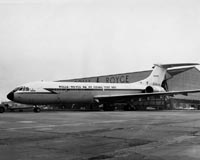Memory does plays tricks .....
Text lifted from
http://www.vc10.net/history/Individual/xr809.html
At that time no aircraft was available that could accommodate the large girth of the RB211 beneath the wing and still have some ground clearance left, the mounting on the side of the fuselage of the VC10 did provide this clearance. Also with the clean wing and relatively high fuselage mounting the RB211 was in clean air and therefore the test results would be universally acceptable. To be able to attach the RB211 the engine beam was strengthened to accommodate the higher weight and aerodynamic effects of the larger frontal area. Also as the RB211 was designed for a pylon mounting some other modifications were needed to adapt to the side-mounted VC10 pylon. All went well and on the first flight of the three-engined VC10 took place on 6th May 1970. On take-off, the two starboard Conways were marginally more powerful than the one RB211.
 G-AXLR with RB211 at Hucknall, Nottinghamshire
G-AXLR with RB211 at Hucknall, NottinghamshireReregistered as G-AXLR the aircraft commenced on an extensive flight test programme. Initially it flew from Hucknall, but from May 1972 on the aircraft was based at Filton from which many more flights were made. One hair-raising flight was the test bed's 44th flight on 7th august 1974. The thrust reverser on the RB211 was not used at this point but for some reason the reverser sleeve was not positively locked in the forward position. With an expected flight time of six hours the aircraft took off laden with fuel. An incremental climb was carried out, pausing every so often for re-lights on the RB211. Following a re-light with the aircraft flying at 240 knots at 20,000 feet, the cold stream reverser of the RB211 slid back into the reverse position, sealing off the bypass duct. The effect of this was a reverse idle which produced a slight lurch on the aircraft. Shortly afterwards, a more violent lurch occurred, followed by aircraft buffet. There was adverse yaw and roll, and level flight could not be maintained with full power on the Conways. The aircraft began descending at 2,500 feet per minute and, as the crew had no control over the reverse selection, the RB211 was shut down. This slowed the rate of descent but the aircraft was still descending at about 1,500 feet per minute.
 The RB211 test engine mounted on G-AXLR
The RB211 test engine mounted on G-AXLR
Fuel jettison was initiated as the equation was quite clear to all on board - the aircraft would hit the ground in approximately twelve minutes unless the weight could be brought down to a value that the Conways could cope with. In such circumstances the time that the Conways can spend on take-off rating become academic. At 1,000 feet the aircraft weight equaled the thrust, and a safe landing was eventually made. After this modifications were carried out to the reverser to ensure a more positive locking system.
On 26th September 1975 the aircraft was delivered to RAF Kemble. Initially the aircraft would return to RAF service but it was found that the airframe was distorted, and repairs were deemed too costly. In the end the airframe was used for SAS training purposes and was left to decay at the site, eventually being scrapped.
When later on Rolls-Royce needed to flight test the RB211-535CF and RB211-535E variants the Boeing 'house' 747 had to be hired for two 30 hour demonstrations at a total cost that just fell short of $10 million.